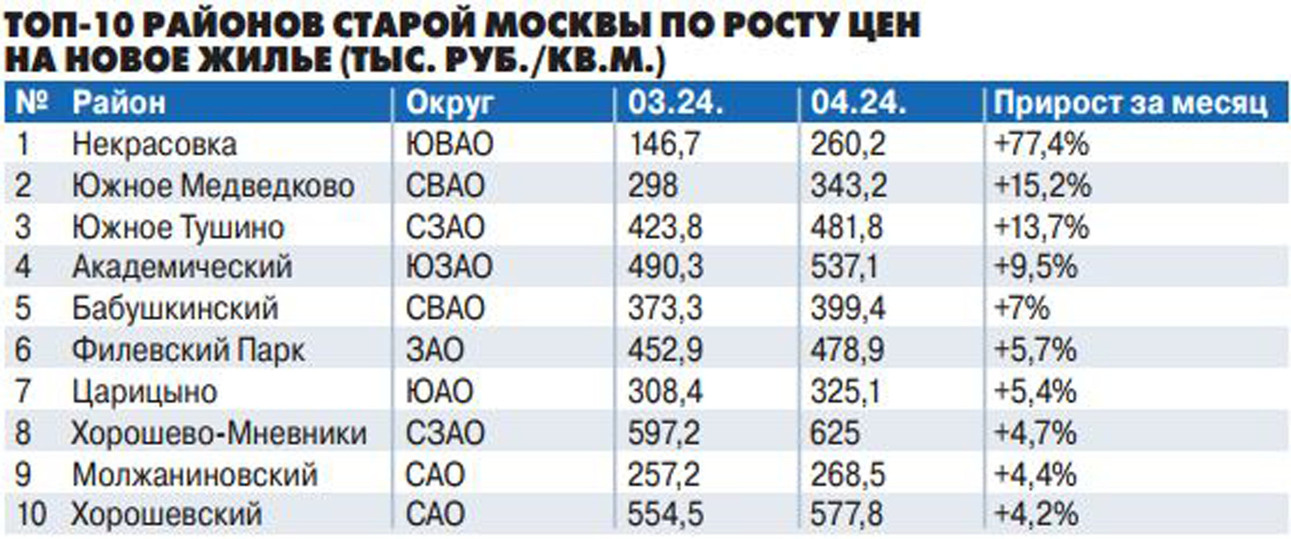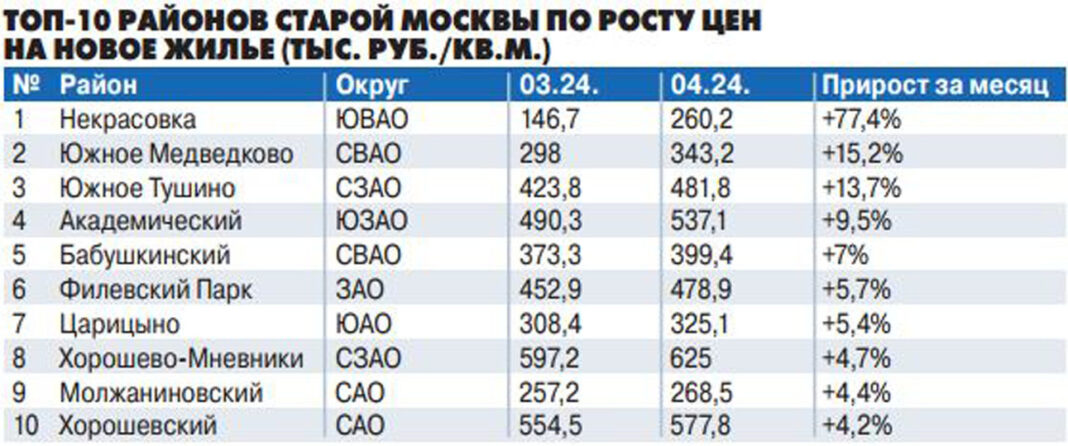For how long?
New sustainable trends have begun to form on the Moscow primary housing market. Moreover, some trends are growing stronger inside the Moscow Ring Road, while others are growing in New Moscow. MK has found out where prices will go in the capital's market for new buildings this summer and what factors will influence the “prices”.
 < /span>
< /span>
As Roman Rodiontsev, director of the project consulting department at Est-a-Tet, told MK, in the spring there was a downward trend in supply on the market for new buildings in “old” Moscow (without the elite segment). In March, the volume of exposure decreased by 6.6% compared to the volume of February, in April the decrease for the month was 1.4%, in May — 1.2%. At the same time, in April, for the first time in a long time, prices for new buildings inside the Moscow Ring Road stopped growing. At the same time, over the year the weighted average supply price increased by 13.6%, reaching 486.3 thousand rubles/sq.m. m. In the mass segment, 1 “square” now costs an average of 335.75 thousand rubles.
In New Moscow, a different picture is observed. If in March the weighted average supply price increased by 1.1% compared to February, then in April the price per month decreased by 1.3% for the first time in a long time, and in May the decline continued (-2.4% compared to April). Now, for 1 square meter in two new districts, developers are asking 248.7 thousand rubles.
According to analysts from the Best-Novostroy company, today the cheapest studio apartment with an area of 15.7 square meters. m. is sold in Kuzminki for 5.13 million rubles. The most affordable one-room apartment (30.8 sq. m.) in the capital will cost 7.52 million rubles. and is located in a comfort-class residential complex in South Butovo. Lots with the lowest prices for apartments within the old borders of Moscow are concentrated in Zelenograd. Here you can buy a studio with an area of 19.4 square meters. m for 4.35 million rubles. or one-room apartments with an area of 32.5 sq.m. for 5.95 million rubles.
In “old” Moscow, the comfort class continues to lose its position, its share in the supply structure continues to decline, while the shares of business class and premium class housing are increasing. “On the new buildings market, the quality characteristics of projects newly entering the market are improving, and the boundaries between classes are becoming more and more blurred. This trend is also observed in the primary housing markets of New Moscow and the region,” Rodiontsev noted.
“Customer priorities are changing. This is especially noticeable in the premium segment. Citizens are increasingly refusing mortgages in favor of installment plans due to high interest rates on loans,” noted Svetlana Bardina, director of the residential real estate sales department of the Summa Elements Group of Companies.
As Optima Development commercial director Dmitry Golev added, sales of premium new buildings have recently increased, as many wealthy Russians have stopped withdrawing funds abroad and are seeking to invest them in reliable and liquid domestic assets.
Another interesting trend is gaining momentum — the average lot area continues to decline. Today this figure in “old” Moscow is 55.2 square meters. m (excluding elite), in New Moscow — 47.3 sq. m. m, in the Moscow region — 46.9 sq. m. Over three years, the decrease in this indicator was: — 2.8% in “old” Moscow, -3.9% in New Moscow and — 7.0% in the Moscow region.
“Changes in mortgage conditions with state support affected demand in the Moscow region. Moreover, this factor most strongly affected the comfort-class housing segments of “old” Moscow, as well as the markets of New Moscow and the region,” Rodiontsev said.
MR Group Product Director Zhanna Makhova drew attention to another important trend — due to a decrease in the availability of mortgages, the share of furnished apartments in sales has decreased to 48%. With high loan rates, clients are reluctant to purchase more expensive (by 15-20%) apartments with finishing, and rely on repairs on their own. Developers are proactive — they are reducing their supply, offering more options without renovation or in the pre-finish format (white box). “A further decrease in the availability of mortgages (both within the framework of market and subsidized programs) will consolidate the trend towards a decrease in the supply of furnished apartments, although they, of course, will not completely disappear from sale — clients are accustomed to this product, and prices for building materials and repairs are on their own are growing,” Makhova emphasized.
In her opinion, there are no prerequisites for a noticeable reduction in prices yet. Demand will remain high even after a possible correction in the summer. Moreover, in the fall, developers have even less incentive to reduce prices, because at this time the high season on the market begins. Therefore, buyers have the greatest chance of a successful transaction during the summer holiday months, when the number of transactions traditionally decreases. During this period, developers are ready to make discounts and offer more favorable terms for installment plans.
Golev also does not expect a significant decline in sales in the second half of 2024: “The Central Bank will soon begin to reduce the key rate, which will make market loans more accessible. In addition, in the near future, savings and loan banks may appear on the market, as well as mortgages for SVO participants and military-industrial complex employees.”
As Roman Rodiontsev believes, the main role in the further development of the situation in the capital’s primary housing market will be played by the key rate of the Central Bank. More precisely, the expectations of market participants for its reduction and return to normal levels. Against the backdrop of statements about the termination of preferential mortgages, buyers will strive to close the purchase before this period. But other programs (family, IT) will support demand, especially if such programs are distributed to a wider audience.
According to Rodiontsev, a ban on the construction of studios could have an additional impact on the housing market. Now this is one of the popular formats for buyers, allowing them to “enter” the market of new buildings with a small budget. Locally, the demand for such lots may jump. And accordingly, their prices may also rise. But since their share is small in the total mass of lots sold, this will not cause a jump in prices.
“The closure of preferential mortgages from July 1 will lead to the fact that the main driver of growth in the primary market will be family mortgages, which are already today provides 30-50% of transactions,” Svetlana Bardina is sure. She recommends that potential apartment buyers pay attention to projects with family-sized apartments, with beautiful views from the windows and developed infrastructure, designed according to the “city within a city” principle. “It is important to compare offers from different developers and choose the most suitable option,” advises the specialist.



